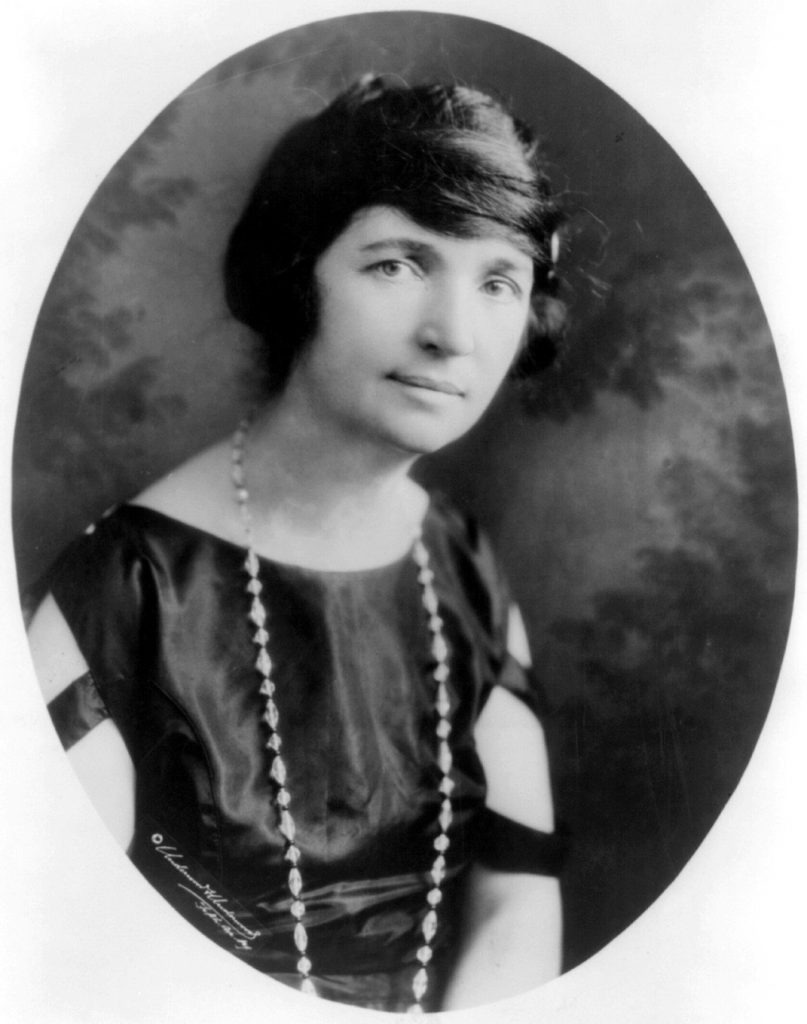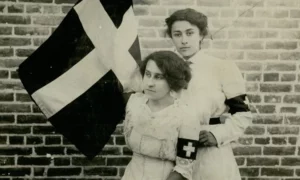Women have proven to be influential when it comes to social reform. During the 1920’s, women began to bob their hair, shorten their skirts, and voice their disdain for various restrictions on women. One of those restrictions involved women’s reproductive health. Margaret Sanger was a pioneer in women’s rights for birth control. Sanger wasn’t afraid to stand up for what she believed in, even if that meant speaking up when the subject was taboo. She was able to help twentieth-century women to gain the right to decide when and if they were to have children. Sanger sought to influence societal norms and cultural beliefs, which have ultimately changed the lives of millions of women to this day.
The 1920s was an eventful decade for women. Not only did women receive the vote, but they also broke longstanding traditions, epitomized by the image of the “flapper.” F. Scott Fitzgerald described the “flappers” of the day as “lovely, expensive, and about nineteen.”1 The flapper attitude was characterized by blunt truth, fast living, and sex. They were seen as reckless and lived in the moment. Most of this, if not all of the behavior was due to World War I. During this time period, men joined the war effort, and women joined the workforce, receiving a paycheck and having disposable wealth, which women used to express their independence. After the war ended, both genders found it difficult to return to society’s previous structure.

“They found themselves expected to settle down into the humdrum routine of American life as if nothing had happened, to accept the moral dicta of elders who seemed to still be living in a Pollyanna land of rosy ideals which the war had killed for them.”2 Before the society’s social structure underwent a transformation, women didn’t necessarily date; they were supposed to wait for a proper suitor to pay them interest, as long as their intentions were good. What once had been “proper” social values were going through changes. One flapper in particular that exemplified these changing values was Margaret Sanger.
On September 14, 1879, Michael Hennessy Higgins and Anne Purcell Higgins gave birth to not only their sixth child (of eleven), but one of the most influential birth-control activists this country has ever known. Aside from the influence growing up with ten siblings, Sanger was also exposed to most of her parents’ Roman Catholic beliefs. After her mother’s death at age fifty, her father relinquished his own Roman Catholic beliefs, and became an atheist. In becoming an atheist, Michael Higgins not only changed his personal views but the views of his children, all the while becoming an activist for women’s suffrage. The views of those who raised her (mainly her father), as well as her personal experiences, helped mold her personal views on sex issues, feminism, and ultimately birth control.3
Shortly after that, during her earlier career, Sanger practiced nursing in the destitute areas of the East Side of New York City. In her nursing career, Sanger was exposed to a high level of poverty that included exposure to poor families, and to women that had frequent childbirths, miscarriages, and abortions. During this time working, she started writing educational columns for women, including “What Every Mother Should Know,” and she helped many women who wished to terminate their pregnancies.4 In her experience with the often hidden aspects of child-bearing, Sanger determined the principal focus of her activism: birth control. Because of the things she witnessed, Sanger decided to take the next step in her activism. In March 1914, Sanger published The Woman Rebel, a newspaper that was devoted to educating and raising the consciousness of working women. “This journal was used to assert that every woman has the right to be an ‘absolute mistress of her own body’ including the right to practice birth control.”5
In April 1914, Sanger was notified by the postal authorities that she had violated obscenity laws due to her newspaper. The following May, she declared to the public that The Woman Rebel was “not going to be suppressed by the post office until it has accomplished the work which it has undertaken.”6 Three months later Sanger was formally indicted for violating the Federal Comstock Law. To avoid the risk of spending twenty years in jail, Sanger got on a train to Canada, acquired a false passport, and sailed to England under the name “Bertha Watson.”7 By 1915, after her actions caught the attention of many, Sanger returned to New York to stand trial. Within a few months, her five year old daughter Peggy died of pneumonia. Due to her loss, many expressions of sympathy poured in, and many friends and supporters sent letters and petitions to President Wilson, affirming their support for Sanger.8 With the newly intensified coverage that The Woman Rebel case and the birth control movement had received, to avoid further publicity, the government decided not to press charges.9

Brownsville, New York | Courtesy of Margaret Sanger Papers Project
With this newfound publicity due to The Woman Rebel scandal, Sanger was able to found the first birth control clinic in the United States, on October 15, 1916 in Brownsville, New York. There were some supporters, but others raised their voices against her. Nine days after the grand opening, there was a police raid, and all of the clinic staff (including Margaret Sanger herself) were arrested and prosecuted. In managing these arrests and prosecutions, New York City’s police department may have done more bad than good. Due to the amount of news coverage the arrests made, there were multiple benefactors willing to bail Sanger out, as well as fund the organization. With the newfound publicity, during the month of February 1917, Sanger was able to publish the first issue of her journal, The Birth Control Review.[10. Caroline Katzive, “Margaret Sanger: Demonstrating Leadership and Legacy Through Her Crusade For Women’s Reproductive Rights,” History Teacher 49, no. 1 (November 2015): 130.] She was its editor until 1929, and used her editorials to promote birth control and negative eugenics. “Eugenists emphasize the mating of healthy couples for the conscious purpose of producing healthy children, the sterilization of the unfit to prevent their populating the world with their kind and they may, perhaps, agree with us that contraception is a necessary measure among the masses of the workers, where wages do not keep pace with the growth of the family and its necessities in the way of food, clothing, housing, medical attention, education and the like.”10
Sanger was known for her controversial views. She once proposed allowing Congress to solve “population problems” by appointing a “Parliament of Population.” “Directors representing the various branches of science [in the Parliament would] … direct and control the population through birth rates and immigration, and direct its distribution over the country according to national needs consistent with taste, fitness and interest of the individuals.”11 One interesting view in particular Sanger had, was the way she differentiated “Eugenists” and “Birth Control Advocates.”
We who advocate Birth Control, on the other hand, lay all our emphasis upon stopping not only the reproduction of the unfit but upon stopping all reproduction when there is not economic means of providing proper care for those who are born in health. The eugenist also believes that a woman should bear as many healthy children as possible as a duty to the state. We hold that the world is already over-populated. Eugenists imply or insist that a woman’s first duty is to the state; we contend that her duty to herself is her duty to the state.12
By this point in time, Sanger had made many of the accomplishments toward reaching her initial goals. On November 10, 1921, Sanger founded the American Birth Control League (ABCL) in New York City. She established ABCL to offer an ambitious program of education, legislative reform, and research. Her goal was to build a truly national organization with representation in every region of the country.13

In 1942, The American Birth Control League became the Planned Parenthood Federation of America.14 Even after the name change, the organization continued to strive. It seems as though Sanger knew just which stepping stones it took to reach her goals all the while never straying away from her views on eliminating the unfit.
Throughout her lifetime, Sanger was able to influence many. Not all of the impact during her time as an advocate for women’s issues was positive, considering her highly controversial views. Compared to the way society was when her activism began in the 1920’s, the country’s relationship with birth control has altered substantially. Sanger’s goal was to build a national organization with representation in every region of the country. Today, “Planned Parenthood is one of the nation’s leading providers of high quality health care…and the nations largest provider of sex education…Planned Parenthood has 56 undefended local affiliates that operate nearly 650 health centers throughout the United States.”15 The views of Margaret Sanger inspired the availability of reproductive health care for women across the nation. Sanger started a process in which her actions ignited a series of changes in societal norms. On September 14, 1879 Michael Hennessy Higgins and Anne Purcell Higgins gave birth to not only a revolutionist, but to the creator of the legacy that continues to be Planned Parenthood.16
- St. James Encyclopedia of Popular Culture, 2000, s.v. “Flappers,” by Jackie Hatton. ↵
- Frederick Allen, Only Yesterday: An Informal History of the Nineteen-Twenties (New York: Harper & Brothers Publishers, 1931), 94-95. ↵
- Salem Press Biographical Encyclopedia, January 2016, s.v. “Margaret Sanger,” by Lesley Croft. ↵
- Salem Press Biographical Encyclopedia, January 2016, s.v. “Margaret Sanger,” by Lesley Croft. ↵
- Caroline Katzive, “Margaret Sanger: Demonstrating Leadership and Legacy Through Her Crusade For Women’s Reproductive Rights,” History Teacher 49, no. 1 (November 2015): 128. ↵
- Margaret Sanger, “The Woman Rebel,” The Ban, (May 1914.): 1 ↵
- Caroline Katzive, “Margaret Sanger: Demonstrating Leadership and Legacy Through Her Crusade For Women’s Reproductive Rights,” History Teacher 49, no. 1 (November 2015): 128-129. ↵
- Caroline Katzive, “Margaret Sanger: Demonstrating Leadership and Legacy Through Her Crusade For Women’s Reproductive Rights,” History Teacher 49, no. 1 (November 2015): 129-130. ↵
- Caroline Katzive, “Margaret Sanger: Demonstrating Leadership and Legacy Through Her Crusade For Women’s Reproductive Rights,” History Teacher 49, no. 1 (November 2015): 129-130. ↵
- Margaret Sanger, “Birth Control and Racial Betterment,” The Birth Control Review (April 1919): 11-12. ↵
- Margaret Sanger, “A Plan for Peace,” The Birth Control Review (April 1, 1932): 107-108. ↵
- Sanger, “Birth Control and Racial Betterment,” The Birth Control Review (April 1919): 11-12. ↵
- Caroline Katzive, “Margaret Sanger: Demonstrating Leadership and Legacy Through Her Crusade For Women’s Reproductive Rights,” History Teacher 49, no. 1 (November 2015): 131. ↵
- Salem Press Biographical Encyclopedia, January 2016, s.v. “Margaret Sanger,” by Lesley Croft. ↵
- Planned Parenthood, “Planned Parenthood at a Glance,” Planned Parenthood, (March 2017): https://www.plannedparenthood.org/about-us/who-we-are/planned-parenthood-at-a-glance/ ↵
- Caroline Katzive, “Margaret Sanger: Demonstrating Leadership and Legacy Through Her Crusade For Women’s Reproductive Rights,” History Teacher 49, no. 1 (November 2015): 132. ↵



46 comments
Ernie Sano
Everyone has the right to believe and argue for their own morals and ethics. Having a disagreement or proposing a claim comes with the burden of proof. As the Values and morality of America evolved, it would seem that the ability to find proof in a woman’s choice to reproduce having a negative societal impact dwindled. The realization that one’s subjective view on what is an acceptable way to live your life in terms of reproduction is not grounds for the rejection of birth control. Constitutional reasoning seems to have triumphed over individual ethics.
Cherice Leach
What a great story on such an influential women in United States history! I believe that during the 1920’s was women’s time to thrive. Margaret Sanger did many great things to benefit this country and the women who live in it. It’s empowering to see how much this woman went through just to benefit the other women around her. She is a true inspiration for women and their right’s in the United States.
Andrea Chavez
It is very impressive all that Sanger had to go through to accomplish her goals; and its fascination how not many really cared for what she was on to. And now it’s such a needed thing in our society. This kind of reminds me of certain artists like Van Goh, how in life they never get to see the full success of their work.
Karla Chavana
The 1920’s were times where women’s rights began to strive, and I think that her efforts to bring women the right to control their body was meant to have started then. This woman was at the very least, very brave. She not only advocated for women’s sexual healthcare, but for the fixing of unfair social expectations. Her mission still stands today( planned parenthood) and has proved to help millions of women take control of their lives.
Aaiyanna Johnson
Thanks to Margaret, women had a voice. They no longer were forced to be submissive. I like that in this time women had a choice of whether they wanted a child or not, despite what their partners thought or wanted. I love that the flappers encouraged women to be comfortable in their skin, and to embrace their sexuality, and women were given jobs, one of the first steps to independence. For once, they did not have to rely on their partners for money.
Crystalrose Quintero
I was really able to appreciate that the first paragraph provided groundwork for the rest of the article by summarizing the article. in addition, opening by providing information to the events that would lead up to the main idea I thought really allowed one to fully understand and capture what the 1900’s was all about. the quotes provided describing the opinion of how the people felt about this time period was also a major contributor to being more factual; also allowing us to get a feel of the emotions brought about during that time.
Evelin Joseph
Learning about women in history is still one of my favorite things. Their struggles and leadership encourage me today to take a stand for what I believe in and change the world in my own, small way. Margaret Sanger is one of these courageous women who supported and fought for her beliefs even while having to move out of the country and getting arrested. Through this article I got to see the great risks and lengths Sanger took to eventually build up one of the nation’s greatest health care providers.
Sarah Mares
Margaret Sanger stood up for a plethora of women in the U.S.who just wanted more options regarding their bodies and reproductive health overall. I think that Sander, being in the rough environment she was in as she practiced nursing, was lucky enough to see that these areas (more so. the women in these areas), yearned for a leader who could speak out on their behalf. As Sanger’s focus was primarily on birth control, there were rights that she was fighting for that women never knew had bad they would need it one day.
Matthew Rios
What’s most interesting is how her eugenicist like mind set is exactly an ideal we fought against in WWII with the Nazi regime, yet she is praised and such ideals are overlooked because of the good she has done. It’s important to take note that no matter the moral compass, violations of humankind normally do not go unnoticed, but for some reason she is one of the only real eugenicist that is overlooked. I still believe what she did for woman’s rights was just, and I can honestly say I don’t disagree with much of her ideology. I’m actually thankful woman have such right’s now, but is it at the expense of our humanity and morals? Really a question for oneself I suppose in the end.
Belene Cuellar
I like how this article brings to light the injustice done to women back in the day where birth control was seen as taboo. Our rights were nonexistent and our bodies were merely a breeding factory. The sole purpose of a woman was to raise a family and to care for the husband. I believe that birth control was a major factor in helping women gain a sense of confidence and independence for themselves. Honestly I never knew the history of Planned Parenthood, but I’m glad to learn that this foundation still plays a role in educating individuals about sex and health care. I’m also glad that a woman like Margaret Sanger was able and willing to stand against society’s expectations to achieve women’s rights to their bodies.